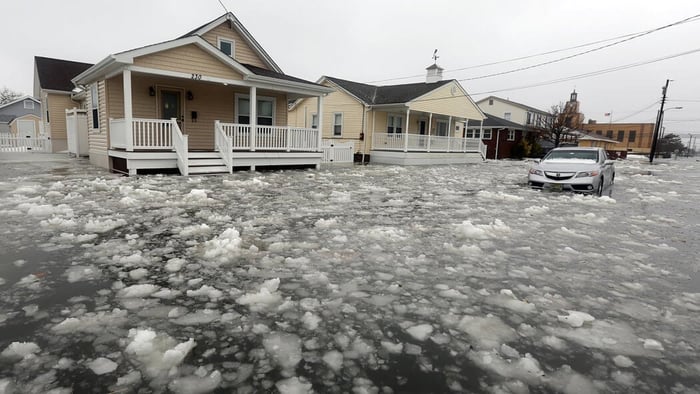Talking about floods, most of us usually imagine autumn or spring flooding due to heavy rainfall or snowmelt. Summer floods are also not that rare, especially in the waterfront areas, where storms can severely alter the coastline and become a natural flooding hazard for the property. But do floods happen in winter?
It might be a surprisingly puzzling question. On the one hand, we mainly think that covered with ice rivers and lakes will become a flooding hazard only in Spring when the melting starts, and therefore, winter floods are not an issue.
However, the constantly changing climate and global warming are now leading to quite unstable weather conditions worldwide. While the environment seems to become more severe, summers are getting hotter, and winters become colder, it is also unpredictable. How many times during the past decade were you weren't really sure whether it would be snowing at Christmas? And how many times did you have to take out warm clothes once again, even though it might have seemed to you that the Spring has come and snow blizzards are far behind?
The climate is changing, and it is changing worldwide. So if several years ago, you might have been surprised by the news that floods happen in winter. Today it is the reality that we all have to live in.

Why do floods happen in winter?
Let's make it clear. In some regions, winter flooding is pretty standard and an annual event due to the peculiarities of the local climate. Therefore in this article, we shall be talking about those countries and regions where winter is still associated with snow and ice rather than running streams of water and mud.
Coastal areas get flooded in winter more often today because of the change in the character of cold and warm sea streams. Causing more massive waves and storms, they alter the coastline and change land quality, making it more prone to flooding. Human impact is, of course, another factor in building waterfront properties; people are altering the coastline significantly, which is another reason for unpredictable winter flooding.
However, floods happen in winter in the in-land areas also. As snow and ice accumulate during cold days, even the slightest rise of temperatures can lead to massive melt, which releases a tremendous amount of water. At the same time, the ground remains frozen and hard as a rock, which prevents excessive moisture from soaking into the soil. It is another reason why floods happen in winter much more often than you might have imagined.
Prepare for winter flooding.
It is essential to start preparing for winter flooding as soon as the first snowfalls.
The water from melted snow is about 1/10 of its volume. In other words, suppose you have 10 inches of snow in your backyard. It means that once this snow melts, you will have to deal with 1 inch of water.
If you have 2-3 feet of snow accumulated around your property, you should prepare for dealing with a pretty severe flooding hazard if the throw comes unexpectedly.
Therefore the first and most efficient measure you can take to prevent winter flooding is to clear the snow from your property and at least 2 feet around it regularly.
Also, don't forget to remove snow from your roof.

When a flood happens in winter
in case the flood does occur in winter unexpectedly. Despite all your efforts, your household is likely to get to your house; here are several essential safety tips that will help you protect your property and make sure that you and your family remain safe during the flood:
- Make sure to move to the highest point of your house. Collect food, warm clothing, and communication devices. Make sure to turn off gas and electricity as they can become additional hazards in case of flooding;
- Once local authorities recommend, don't hesitate to evacuate from the area to higher ground;
- Made sure to seal and secure your house with flood barriers. Use extension poles to block garage doors and basement passages. That way, you will minimize water damage to your property, vehicles, appliance, etc.;
- In case you chose to evacuate, reenter your property only after receiving clearance from authorities, even if you have sealed the building with reliable flood barriers;
- Make sure that your basement is dry before entering it. Electric panels are usually located there, and once they get affected by water, they can cause electric shock if you contact them with your bare hands. To minimize the risk, secure the basement or another area where electric pannels are located first.
Floods do happen in winter, and recently they started to occur more and more often, even in areas that are historically not considered flood-prone. Climate change is irreversible and being prepared for unusual events is the only way to protect yourself from their consequences.
Contact Dam Easy today and learn about our flood barriers and other innovative anti-flooding solutions that will help you protect your property from flooding all year round. They are easy to install and remove and provide you thorough protection even in unexpected flooding.
Flood Barrier Door Dam - Ultimate Flood Gate

$949.00
DAM EASY® FLOOD GATE - DOOR DAM Floods are becoming more common around the world. What was once a 100-year phenomenon is now a seasonal trend that homeowners must deal with. That’s EXACTLY why you need this Dam Easy Flood… Read More



